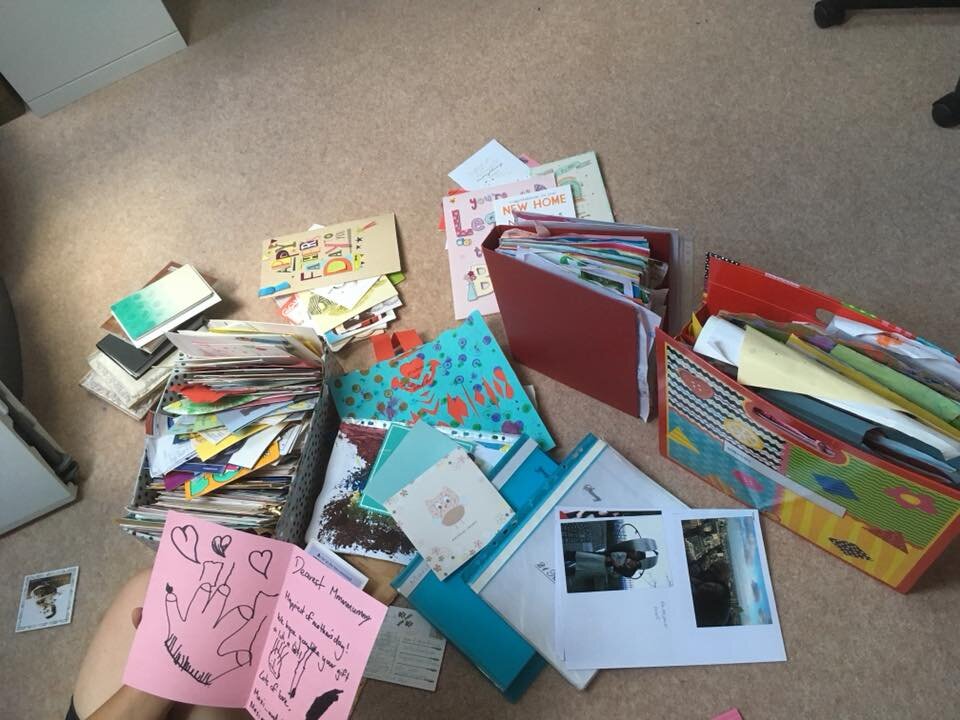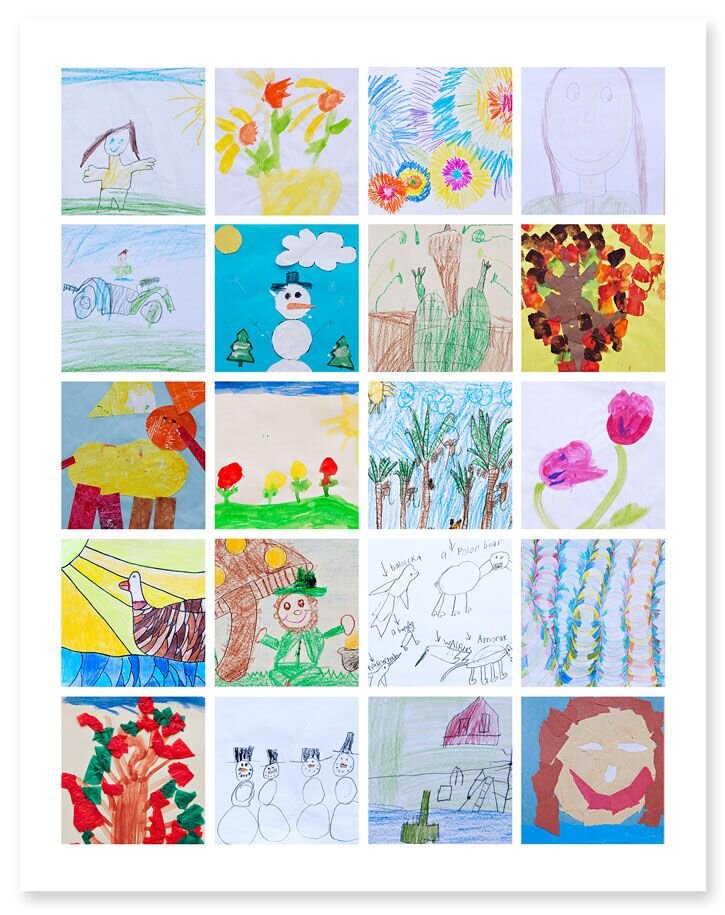Overwhelmed By Children's Artwork? Here's My Advice On How To Regain Control
Let’s check in with how we feel right now after reading part of the title of this blog post: Overwhelmed By Your Children’s Artwork? Does the idea of the volume of artwork currently stored in your home make you want to crawl under a duvet and hide? Chances are, if you’re reading this post right now, you’re either feeling overwhelmed and don’t know where to start and/or you’re interested in finding out about different ways to store artwork long term. If it’s the latter, I will be covering my favourite ways to display/store children’s artwork in my blog post next week.
In this post, I’m going to focus on how you can regain control over the artwork that currently lives in your home. This is the first step. We have to examine the content first and choose what you’d like to keep, instead of investing in the ‘prefect’ storage solution to give a home to every single piece of artwork that comes through your door. Whenever I work with clients, I tell them to sort first, and store later.
Let’s identify what the issue is…
Client SR - Artwork & Greeting Cards Before
If you’re like many of the clients that I work with on their tidying journey, artwork is one of those subcategories that opens up a highly emotional can of worms. In my experience, these are some of the key reasons why people find themselves drowning in their children’s artwork:
Simply, there’s too much of it coming in and due to feelings of overwhelm, you have lost the motivation to find a solution.
You don’t know how to sort through the artwork to decide what stays and what goes.
You feel emotionally attached to their artwork and feel guilty about letting any of it go.
Your children want to keep EVERYTHING.
Can you relate to any of the above? If so, that’s great because you’ve identified what is holding you back. Now it’s time to explore each one of these barriers further and make a change.
Barrier 1: There’s too much coming in and I’ve lost motivation
I’ll be up front and honest, here’s the bad news: we can’t do much about the volume coming in as it’s an outside source. Unless you’re willing to have an open conversation with your child’s class teacher warning them not to send stuff home (yes, I can’t see this happening either), artwork coming into your home is inevitable. Here’s the good news: you haven’t lost motivation because you’re reading these words right now. If you’d lost motivation completely, you’d avoid this post like the plague.
Here’s the silver lining: I have seen with my own eyes that the children of some of my clients, who have had the experience of going through their own KonMari tidying journey, have developed the ability to complete joy checks in school. It’s true, this artwork didn’t leave the school building because these children had already said goodbye to it in school!
Barrier 2: I don’t know how to sort through my child’s artwork
Earlier this year, I worked with a lovely local client who had three children. She had already gone through the KonMari categories of clothing, books, papers and komono but had gotten stuck on sentimental items. She hit her tidying wall with her children’s artwork. Her children were 11, 8 and 5, resulting in a tremendous backlog of artwork she accumulated through the years. She had kept every single piece of artwork they had ever created and did not know where to start. That’s where I came in! In one session of 5 hours, we were able to sort through her artwork to determine what stayed and what was recycled with gratitude.
NOTE: My client was engaging in what I like to call ‘wave one’ of tidying children’s things. Wave one means that a parent alone completes the first task of going through the items to whittle it down to an amount that children can go through without feeling overwhelmed. Some clients I work with like their children to be present at all times when they’re going through their artwork and I’d say this works in around 20% of cases. The older your child, the more success you may have. But the truth is, going through every single piece of artwork, particularly if children have a lot, is overwhelming for little people and they can get bored and distracted easily, resulting in them wanting to keep everything just to get out of the task of tidying! This isn’t advisable because we want tidying to be a joyful event. Therefore, if you complete wave one, your children then have the less stressful opportunity to engage joyfully in ‘wave two’ where they’re able to complete their own joy checks.
If you decide to complete a ‘wave one’ sort like my client, here are the steps to take:
Gather all of your child’s/children’s artwork in one place. I’d advise somewhere out of sight of little eyes and hands. My client chose to work in her attic conversion.
Separate your child’s artwork into subcategories (piles). If you have one child, this could be by year (roughly) or by art type (paint, drawing, collage, 3D etc.). If you have more than one child like my client, organise the artwork by child.
Set a criteria for what stays. Through taking each piece of artwork in her hands, one at a time, very early on my client was able to set her ‘keep criteria’ for the pieces she was keeping. Most of the artwork which had a little mark or scribble on was recycled. If my client found something that sparked a memory or was a milestone (like writing their name or creating their first rainbow in paint), she decided to keep it. Quickly after that, my client became increasingly aware of duplicates: she didn’t need to hold on to 20 paintings of a rainbow, when the 1 or 2 that sparked a memory had already passed the joy check. By setting the criteria for what stays and whittling down the amount, you’re helping your children in the long term by saving them from trying to create the criteria themselves (which is often extremely difficult for a child to do).
Once you have your joy checked piles of artwork, I recommend taking a little breather (make a cuppa or pour yourself a glass of wine!) before checking through the contents of each pile one more time.
Following this, you have two options. 1: To involve your children in their joy checks on what is now there. 2: To figure out a way to store the artwork long-term (more on this in next week’s blog post).
Barrier 3: I feel too emotionally attached to the artwork to let any of it go
Here are a few things I hear quite often when it comes to letting go of children’s artwork:
‘I might regret getting rid of it.’
‘If I don’t keep it, they take it very personally.’
‘My child worked so hard on it.’
‘They made this for me. I could never let it go.’
If you hear yourself saying one of these things during the sort, you have an emotional attachment to their artwork. And that’s okay. Remember, KonMari isn’t about getting rid of things. It’s about keeping the things you love and surrounding yourself with joy. The goal is to identify the things that spark the most joy for you to set the standard for everything else. This doesn’t work though, when you’re emotionally attached to every single piece of artwork. Be honest with yourself and ask: is every piece of artwork significant enough to keep?
The truth is, the more you keep, the less significant individual items become. They will be drowned out by everything else. Because there are so many of them, the likelihood that a piece will be displayed, framed, digitalised into a keepsake book is reduced, as is the item’s significance. By keeping a number of pieces, chosen with intention, you actually elevate their status and provide yourself with the freedom to turn them into something beautiful. After all, keeping less = less time organising. One good question to ask yourself when you look at every piece of artwork is: Am I willing to invest the time it takes to display this / store it in a meaningful way? This can help you to distinguish what’s worth keeping by considering it’s eventual resting place. The more you keep, the more resting places you need to create or find.
Barrier 4: My children want to keep EVERYTHING
One of the reasons why children hold on to their things is because they haven’t yet had the practice in letting things go. Being able to say goodbye to items is a skill even adults find difficult. I believe, if they are willing, children should go through the KonMari Method in the same way that adults do: by category in order starting with clothing, before moving on to books, papers, komono (toys, toiletries, electronics and knick knacks) and finally sentimental items. When tackling artwork, children can tidy this during the paper category or, if they have a great deal of emotional attachment to their artwork, they can assign artwork to the sentimental category. We need to give them the practice in completing their ‘happy checks’ in all of the other categories first before asking them to make decisions about their artwork, which can often be quite precious to them because it is something that they have created.
Another important consideration is whether you, as their parent, have modeled positive behaviour in letting items go with gratitude. If our children seeing us saying goodbye, they are far more likely to emulate that behaviour. We are their role models in teaching them that this is a valuable life skill. We needn’t feel any guilt in thanking the item and recycling it. We could allow them to keep everything, but how does that impact on the years ahead and the mountain of stuff they accumulate as they grow?
For more information on how to use the KonMari Method to teach your child how to tidy, take a look at my posts:
So based on the above, what is your next step? How are you going to take action?
It may seem like your children's artwork is a mountain you’re unable to climb, but trust me, all it takes is some investment of your time and energy to reset the status quo and ignite a positive change in strategy as you continue to monitor incoming artwork in the future. You’ll be so glad you did this now, particularly if your children are still young. Can you imagine doing this once they’ve left home?! No, I can’t either. You’ve got this. If you still have any questions, write them in the comments or seek help. I’m always here if you need me.





